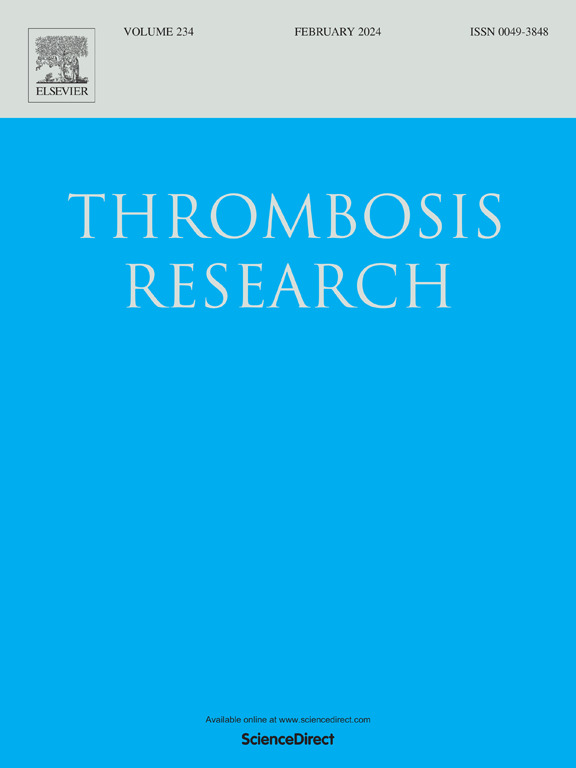癌症相关内脏静脉血栓的抗凝治疗:一年随访期间的结果
IF 3.4
3区 医学
Q1 HEMATOLOGY
引用次数: 0
摘要
近年来,由于生存率的提高和定期放射检查的广泛使用,癌症患者的内脏静脉血栓(SVT)发生率有所增加。然而,描述抗凝治疗的长期预后和益处的研究很少。目的是描述长期预后,并在一年随访期间比较抗凝治疗的结果。材料和方法本研究是一项回顾性观察性研究,纳入了2015年至2020年间住院的连续患者,这些患者在入院前或住院期间被诊断为癌症相关的上腔静脉血栓。结果201例患者,以腹内肿瘤(78.2%)为主,其中以胰腺癌(43.8%)居多。门静脉血栓形成(58.6%)是最常见的SVT类型。大约41.3%的病例在诊断为SVT时接受了抗凝治疗。12个月总生存率为39.7%。抗凝治疗与再通和出血的累积发生率显著升高相关。然而,两组在血栓形成的存活率和复发率方面没有差异。肿瘤血栓(OR 2.44;CI 95% 1.32-4.52)和肿瘤转移状态(OR 3.07;CI 95%(1.63-5.8)是死亡的预测因素。结论ssvt是肿瘤患者常见的并发症,尤其是腹部肿瘤患者。肿瘤血栓和转移情况为不良预后因素。抗凝治疗与更高的再通率以及更高的出血风险相关,对生存或预防血栓复发没有好处。本文章由计算机程序翻译,如有差异,请以英文原文为准。
Anticoagulant therapy for cancer-associated splanchnic vein thrombosis: Outcomes during a one-year follow-up period
Introduction
The incidence of splanchnic vein thrombosis (SVT) in cancer patients has increased in recent years due to improved survival rates and the widespread use of scheduled radiological tests. However, studies describing the long-term prognosis and benefits of anticoagulant treatment are scarce. The objectives were to describe long-term prognosis and to compare outcomes based on anticoagulant treatment during a one-year follow-up.
Material and methods
This was a retrospective observational study of consecutive patients hospitalized between 2015 and 2020 with a diagnosis of cancer-associated SVT either prior to admission or during hospitalization.
Results
The study included 201 patients, with intra-abdominal tumors (78.2 %) predominating, particularly pancreatic cancer (43.8 %). Portal thrombosis (58.6 %) was the most common type of SVT. Approximately 41.3 % of cases received anticoagulant treatment at the diagnosis of SVT. The overall survival rate at 12 months was 39.7 %. Anticoagulant therapy was associated with a significantly higher accumulated incidence of recanalization and bleeding. However, no differences were found in the survival and recurrence of thrombosis. Tumor thrombus (OR 2.44; CI 95 % 1.32–4.52) and the metastatic status of the oncological disease (OR 3.07; CI 95 % 1.63–5.8) were predictive factors for death.
Conclusions
SVT is a common complication in cancer patients, particularly in those with abdominal tumors. Tumor thrombus and metastatic status were negative prognostic factors. Anticoagulant treatment was associated with a higher rate of recanalization as well as a higher risk of bleeding, without benefits on survival or prevention of thrombosis recurrence.
求助全文
通过发布文献求助,成功后即可免费获取论文全文。
去求助
来源期刊

Thrombosis research
医学-外周血管病
CiteScore
14.60
自引率
4.00%
发文量
364
审稿时长
31 days
期刊介绍:
Thrombosis Research is an international journal dedicated to the swift dissemination of new information on thrombosis, hemostasis, and vascular biology, aimed at advancing both science and clinical care. The journal publishes peer-reviewed original research, reviews, editorials, opinions, and critiques, covering both basic and clinical studies. Priority is given to research that promises novel approaches in the diagnosis, therapy, prognosis, and prevention of thrombotic and hemorrhagic diseases.
 求助内容:
求助内容: 应助结果提醒方式:
应助结果提醒方式:


